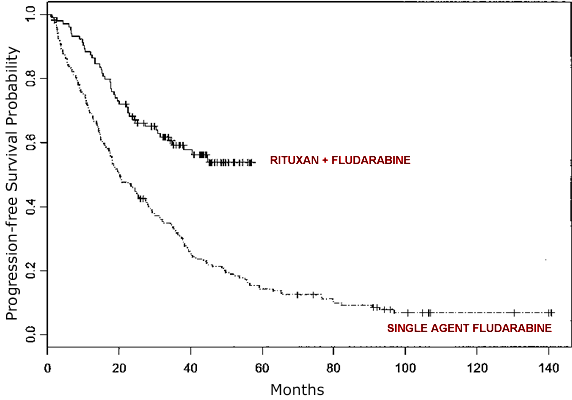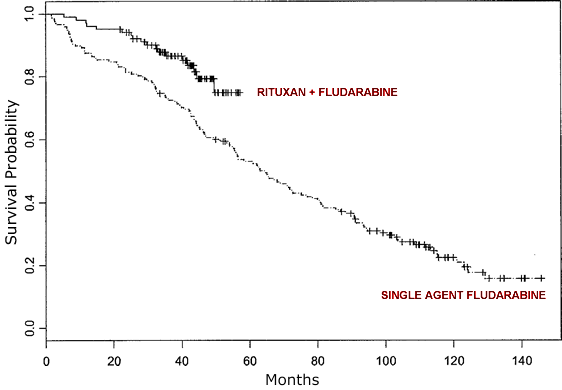 |
||||||||||
Date: May 13, 2024
by Chaya Venkat
Related Articles:

Those of us exploring cutting-edge new options to treat CLL may think every one has heard of Rituxan and Campath, names that have become household words in our patient community. Not so. It should not surprise you to know that for the vast majority of CLL patients both in this country and elsewhere in the world, their first encounter with therapy is fludarabine as single agent. Standard chemotherapy with fludarabine is considered the safe "gold standard" by most local oncologists and community practitioners, to this day. I suppose health care costs and public policy have something to do with it as well, since fludarabine is a lot cheaper than monoclonal antibodies such as Rituxan and Campath, especially now since fludarabine has come off patent. Heck, I have seen an even older generation drug, chlorambucil, recommended as front-line therapy in several European articles. Fludarabine and chlorambucil certainly have their role to play and may be appropriate therapy in some situations. But as unquestioned frontline single agent therapy for all CLL patients? That bears closer examination.
If we put aside public policy issues and drug costs and focus instead only on ability to hold the CLL at bay as well as increase overall patient survival, it is easy to see that an era is coming to an end. The latest edition of "Blood" has two important articles that have very crucial information for CLL patients. Both deal with the subject of fludarabine. The abstracts of both articles are given below. I am reviewing pre-publication on-line articles, you may not be able to get these articles in regular print for a couple of weeks. Let us know if you need help in locating the full-text versions of these two pivotal articles, we would be happy to assist you. Do your fellow CLL patients a favor. Print out and take hard copy of the first article to your local oncologist. You would be surprised how much of an impact you can have on the treatment of the next CLL patient that walks in the door. As a patient community, we have to help make this transition happen, changing perspectives one oncologist at a time.
This important paper compares the results of two separate trials conducted by the CALGB group, the author list reads like a who's-who of CLL experts.
CALGB 9712 was a randomized phase II study, patients accrued from 1997 to 1999. Rituxan was administered either concurrently (51 patients) or sequentially (53 patients) with fludarabine. Initial reports suggested that the concurrent administration yielded better results than the sequential information, but based on more recent finding that the progression free survival and overall survival of both the concurrent and sequential arms were quite similar, all 104 patients enrolled on this trial were combined into one comparison group for the analyses reported in this paper. We reviewed this particular trial in detail in an earlier article, RF Therapy, if you wish to refresh your memory.
CALGB 9011 was an older trial open to accrual from 1990 to 1994. It randomized patients to either fludarabine or chlorambucil as single agents, or their combination. The fludarabine-only arm of that trial, in which 178 patients participated, was used in the present paper.
The eligibility criteria of the two studies were virtually identical, as you can see in the patient characteristics table below. All patients were either Rai stage III/IV or Rai stage I/II if there was evidence of disease activity as defined by the NCI 1996 guidelines. None of the patients had received prior therapy. Neither trial permitted viral or bacterial prophylaxis, nor was there prospective monitoring for cytomegalovirus infection. (Phew!! Now you understand why I say we owe a debt of gratitude to patients who volunteer for these clinical trials. How else would we find out about the potential toxicity of the various therapy regimens, but for these guys putting their bodies on the line without the safety net of pre-emptive viral or bacterial medications?)
| Patient Characteristics / Response | CALGB 9712 (R+F) | CALGB 9011 (F Alone) |
| Patient Characteristics | ||
| Number of Patients | 104 | 178 |
| Median Age | 63 | 64 |
| % Patients < 50 years | 14 | 14 |
| % Patients > 70 years | 23 | 25 |
| % Rai Stage I & II | 59 | 57 |
| % Rai Stage III & IV | 40 | 43 |
| % with Enlarged Liver | 15 | 20 |
| % with Enlarged Spleen | 61 | 68 |
| Median WBC (109 /L) | 83 | 77 |
| Median Hemoglobin (g/dL) | 12.3 | 12.2 |
| Median Platelets (109/L) | 158 | 155 |
| Response | ||
| % Overall Response | 84 | 63 |
| % Complete Response | 38 | 20 |
| 2-year Progression-free Survival Probability | 67 | 45 |
| 2-year Overall Survival Probability | 93 | 81 |
Progression-free and overall survival graphs are shown below. They are presented in the paper titled "The Addition of Rituximab to Fludarabine May Prolong Progression-Free Survival and Overall Survival in Patients with Previously Untreated Chronic Lymphocytic Leukemia: An Updated Retrospective Comparative Analysis of CALGB 9712 and CALGB 9011", by John C. Byrd, et. al., in the May 11, 2024 Blood First Edition Paper abstracted below.
Progression-Free Survival RF vs. F
John C. Byrd, et al., Blood First Edition Paper

Overall Survival RF vs. F
John C. Byrd, et al., Blood First Edition Paper

The authors noted that neutropenia, hypotension (low blood pressure) were more commonly noted in the fludarabine + rituximab treatment group, but no difference in other hematological toxicity such as anemia or thrombocytopenia. The addition of rituximab to fludarabine did not appear to increase the risk of grade III or IV infections or Herpes virus infections. Not bad at all, a twelve percent difference in 2 year overall survival advantage is something to cheer about! In human terms, that is 12 patients out of a hundred who made it alive past the two year mark, if they got the Rituxan plus fludarabine combo instead of just fludarabine. I hope many of you will actually want to look at the full text paper. It should knock your socks off and hopefully convince you that fludarabine as frontline and single agent therapy is probably not your best option today.
The obvious limitation of this analysis is the retrospective nature of the comparison, the researchers had not planned for this kind of comparison at the time of initiating these two clinical trials. It is fortunate that the two patient groups turned out to be as comparable as they are. The authors suggest that it will be important to determine if select molecular risk factors such as IgVH mutation status, ZAP-70 expression, or FISH results such as p53 deletion have even more of an impact on patient response to these two therapy regimes. Interphase FISH cytogenetics and molecular studies are currently being examined for patients enrolled in the later Rituxan & Fludarabine trial (CALGB 9712). That is the best news I have heard, looking to see if therapy options should be tailored to suit risk category of patients. Breaking out responders versus non-responders on the basis of modern prognostic information should be an essential ingredient of all well designed clinical trials. This has been the consistent recommendation of CLL Topics, that we adopted a risk-based therapy approach for CLL patients, not the one-size-fits-all approach of years gone by.
Dear Reader, if you do not yet know your risk profile, may I suggest a few articles for you to read:
What Type of CLL Do You Have?
Immunotherapy for a Difficult Case (RHK I)
The Continuing Saga of the Round-headed Kid (RHK II)
FISHing for Answers
Need To Know (Mayo Best Practices)
Prognosis at Diagnosis
The life you will save by your increased awareness will be your own.
All too often, I see clinical trial results reported that are sketchy on the details, or with too few patients to draw statistically valid conclusions. In my naive youth I used to think there was some unwritten code that said recruitment of human patients was done only into sufficiently robust clinical trials, where the generous volunteer efforts of the participants paid off in high quality information that benefited future generations. I became more cynical as I saw almost anecdotal quality data reported, less than a handful of patients participating, claims of efficacy based on skimpy grounds such just peripheral blood data if that suited the argument, lymph nodes measured with a ruler if that worked better. More often than not, when comparisons are made between experimental and control groups, not enough information is presented to judge whether the comparison is appropriate, or a matter of juggling apples and oranges.
The highly praised objectivity and scrupulous attention to detail that we assume in researchers is not always there. That is why it is such a pleasure to review this article. I am delighted with the details presented in comparing the patient characteristics, the methodology used in these two studies and the painstaking statistical analysis. The substantial size of the two patient groups, rigorous record keeping and the excellent match between the two groups makes the conclusions very convincing.
Gentlemen, take a bow. Our congratulations and sincere thanks for a truly important and seminal comparison that will influence CLL therapy decisions for many patients. We expected no less from an expert group such as you.
Blood First Edition Paper, prepublished online May 11, 2024; DOI 10.1182/blood-2004-03-0796.
The Addition of Rituximab to Fludarabine May Prolong Progression-Free Survival and Overall Survival in Patients with Previously Untreated Chronic Lymphocytic Leukemia: An Updated Retrospective Comparative Analysis of CALGB 9712 and CALGB 9011
John C Byrd*, Kanti Rai, Bercedis L Peterson, Frederick R Appelbaum, Vicki A Morrison, Jonathan E Kolitz, Lois Shepherd, John D Hines, Charles A Schiffer, and Richard A Larson
Fludarabine and rituximab combination therapies in chronic lymphocytic leukemia (CLL) have yielded promising early results, but no comparative efficacy data relative to standard fludarabine treatment regimens have been reported. To assess the impact of the addition of rituximab to fludarabine therapy, we retrospectively compared the treatment outcome of patients with similar clinical characteristics enrolled on two multi-center clinical trials performed by the Cancer and Leukemia Group B and the US Intergroup that utilized fludarabine and rituximab (CALGB 9712, n=104) or fludarabine (CALGB 9011, n=178). In multivariate analyses controlling for pre-treatment characteristics, the patients receiving fludarabine and rituximab had a significantly better progression-free survival [PFS] (p<0.0001) and overall-survival [OS] (p=0.0006) than patients receiving fludarabine therapy. Two-year PFS probabilities were 0.67 versus 0.45, and 2-year OS probabilities were 0.93 versus 0.81. Infectious toxicity was similar between the two treatment approaches. These comparative data are retrospective and could be confounded by differences in supportive care or dissimilar enrollment of genetic subsets on each trial. Confirmation of these findings will require a prospective randomized trial comparing fludarabine and rituximab to fludarabine
_______
If the half dozen or so articles on our website have not yet convinced you that modern prognostic information is important in making therapy decisions, and that it is to your advantage to get a good understanding of how different drugs work, the following article may help convince you. Ignorance is not bliss, where cancer therapy is concerned. You may be one of the lucky ones with a caring, well-informed and smart hematologist/oncologist, some one whom you trust to make the right decisions for you. But for the vast majority of us, it stands to reason that an informed consumer of healthcare is also a better served patient. You read Consumer Reports, walk around and kick the tires, take the new car out on a test drive before you buy it, right? Or do you just take the word of the car salesperson on the lot? You should be at least as involved in therapy decisions that involve your very life.
In its day, development of fludarabine therapy was a milestone in therapy options for CLL. Treatment with fludarabine gave higher remission rates, longer progression-free survival and increased the median duration of remission, compared to the then available drug, chlorambucil. All that was good news for CLL patients, but unfortunately there was no demonstrated increase in overall survival in previously untreated CLL patients.
Fludarabine works by incorporating itself into the DNA of cells, and thereby breaking the DNA double strands. Double strand breakage is a major disaster as far as the cell is concerned, putting it beyond any hope of repair and patch-up. Under normal circumstances, such cells die very quickly, and the orderly death of the cell is orchestrated by TP53 gene. Since it has been shown that fludarabine-induced DNA strand breaks lead to the activation of p53, it is reasonable to expect p53-controlled apoptosis plays a central role in the killing of CLL cells after fludarabine therapy.
Which leads us to the million dollar question, what about our "Bucket C" kids, those with cytogenetic mutations in TP53 gene, and/or its side-kick the ATM gene? How does fludarabine work for these folks? Sure enough, TP53 mutations in CLL is associated with poor prognosis and even more important, resistance to fludarabine treatment. (If you wish to learn more about TP53 and ATM genes and how they influence your prognostics, you may want to read our article, Cytogenetics of ATM and TP53).
This study is not your usual clinical trial, it was geared more to understand how fludarabine worked, the details of changes in gene expression as patients went through fludarabine therapy. 7 patients were enrolled in this study, with a wide range of patient characteristics. The work is detailed and painstaking, but not geared for easy comprehension by laypersons or patients. So I will make it easy on you, give you the punch lines.
So far, no surprises. Here is a direct quote from the paper that caught my eye, the highlighting is my own contribution:
"Our finding that fludarabine activated a p53 response in all of our study patients has implications for the clinical management of CLL. Our results suggest that treatment of CLL patients with fludarabine has the potential to select for outgrowth of p53 mutant sub-clones that would be cross-resistant to several other chemotherapeutic agents. It is also possible that p53 mutant CLL cells could cause a more aggressive disease based on recent evidence that deletion of the p53 locus is associated with poor prognosis......... Further, the use of fludarabine could also be guided by prognostic data based on the immunoglobulin mutation status of the leukemic cells ZAP70 expression by the CLL cells and cytogenetic abnormalities".
To translate, these authors (from the Center for Cancer Research, National Cancer Institute, NIH, no less), are saying that even when a CLL patient responds very well to fludarabine therapy, there is a risk. There is a possibility that since the CLL is by no means fully eradicated by fludarabine therapy, the cancer cells left behind may be the particularly nasty and hard to kill TP53 mutant cells. Remember, fludarabine cell-kill depends on proper functioning of the TP53 gene. So it makes sense that the majority of the CLL cells left behind to breed may be the ones that have defective TP53 function. With all the other CLL cells killed by fludarabine, no competition in sight and a wide open field, the eco-niches of your body may get dominated by this dangerous sub-clone. If this happens, you really have a problem, since CLL cells with p53 deletion are hard to kill by many of the common chemotherapy drugs. If this scenario plays out, the patient is not only resistant to fludarabine, but has developed multi-drug resistance. Ouch!
The concept that fludarabine monotherapy is not a slam dunk decision, but one that should be based on modern prognostic risk assessment is gaining ground. Frankly, with this many experts weighing in on this issue, I am at a loss to understand why this message is not percolating to the local and community healthcare level at a faster rate.
You know the saying, if you want something done right, do it yourself. So how about it folks, how about getting a little motivated and mobilized to help ourselves and our fellow CLL patients? How about getting the word out, to other patients, their care givers, and their perfectly well meaning but busy local healthcare providers? We have reviewed several papers in the past few months, articles such as "Prognosis at Diagnosis", "Mayo best practices", and this latest pair of articles on the role of fludarabine. In the opinion of this reporter, these articles should be mandatory reading for all doctors treating CLL patients. How about making things just a little easier for your over-worked and harried oncologist, by taking him/her hard copies of the articles that you think are important for him or her to read? We are more than happy to help you locate full-text hard copies of any of the articles we review on our website, for your personal and non-commercial use. All you have to do is write to us. You will be pleasantly surprised how much of an impact you will have by this simple act.
Blood First Edition Paper, prepublished online May 11, 2024; DOI 10.1182/blood-2003-09-3236.
Fludarabine Treatment of Chronic Lymphocytic Leukemia Patients Induces a p53-Dependent Gene Expression Response
Andreas Rosenwald, Eric Y Chuang, R E Davis, Adrian Wiestner, Ash A Alizadeh, Diane C Arthur, James B Mitchell, Gerald E Marti, Daniel H Fowler, Wyndham H Wilson, and Louis M Staudt
Fludarabine, the current standard treatment for B-cell chronic lymphocytic leukemia (CLL), can induce apoptosis in CLL cells in vitro, and a number of molecular mechanisms contribute to its cytotoxicity. Using gene expression profiling, we investigated the molecular consequences of fludarabine treatment of CLL patients in vivo. In 7 CLL patients, a consistent gene expression signature of in vivo fludarabine exposure was identified. Many of the fludarabine signature genes were known p53 target genes and genes involved in DNA repair. In vitro treatment of CLL cells with fludarabine induced the same set of genes as observed in vivo, and many of these genes were also induced by in vitro exposure of CLL cells to ionizing radiation. Using isogenic p53 wild-type and null lymphoblastoid cell lines, we confirmed that many of the fludarabine signature genes were also p53 target genes. Since in vivo treatment with fludarabine induces a p53-dependent gene expression response, fludarabine treatment has the potential to select p53-mutant CLL cells, which are more drug resistant and associated with an aggressive clinical course. These considerations suggest that fludarabine treatment should be given in strict accordance to the current NCI guidelines that have established criteria of disease activity that warrant treatment.
________
 Enter Keywords: |
———
Disclaimer: The content of this website is intended for information only and is NOT meant to be medical advice. Please be sure to consult and follow the advice of your doctors on all medical matters.
Copyright Notice:
Copyright © 2024-2007 CLL Topics, Inc. All Rights Reserved.
All materials contained on this site are protected by United States copyright law and may not be reproduced, distributed, transmitted, displayed, published or broadcast without the prior written permission of CLL Topics, Inc. You may not alter or remove any trademark, copyright or other notice from copies of the content.
However, you may download and print material from CLLTopics.org exclusively for your personal, noncommercial use.
———
